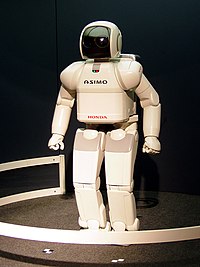
Photo from wikipedia
Abstract Social robots serve people as tutors, caretakers, receptionists, companions, and other social agents. People know that the robots are mechanical artifacts, yet they interact with them as if they… Click to show full abstract
Abstract Social robots serve people as tutors, caretakers, receptionists, companions, and other social agents. People know that the robots are mechanical artifacts, yet they interact with them as if they were actual agents. How is this possible? The proposal here is that people construe social robots not as social agents per se, but as depictions of social agents. They interpret them much as they interpret ventriloquist dummies, hand puppets, virtual assistants, and other interactive depictions of people and animals. Depictions as a class consist of three physical scenes with part-by-part mappings between them: (a) a base scene (the raw physical artifact), (b) the depiction proper (the artifact construed as a depiction), and (c) the scene depicted (the scene people are to imagine). With social robots, evidence shows people form the same three scenes plus mappings: They perceive the raw machinery of a robot, construe it as a depiction of a character, and, using the depiction as a guide, engage in the pretense that they are interacting with the character depicted. With social robots, people also recognize three classes of agents – the characters depicted, the intended recipients of the depictions (those who view or interact with the robots), and the authorities responsible for the robots (the designers, makers, and owners). Construing social robots as depictions, we argue, accounts for many phenomena not covered by alternative models.
Journal Title: Behavioral and Brain Sciences
Year Published: 2022
Link to full text (if available)
Share on Social Media: Sign Up to like & get
recommendations!